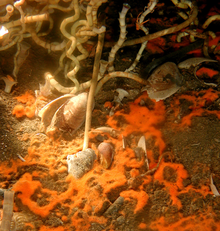Lamellibrachia luymesi
| Lamellibrachia luymesi | |
|---|---|

| |
| Scientific classification | |
| Domain: | Eukaryota |
| Kingdom: | Animalia |
| Phylum: | Annelida |
| Clade: | Pleistoannelida |
| Clade: | Sedentaria |
| Order: | Sabellida |
| Family: | Siboglinidae |
| Genus: | Lamellibrachia |
| Species: | L. luymesi
|
| Binomial name | |
| Lamellibrachia luymesi van der Land & Nørrevang, 1975
| |
Lamellibrachia luymesi is a


Lamellibrachia luymesi provides the bacteria with
To support the carbon fixation they need for maintenance and growth, L. luymesi needs to extract sulfide, oxygen, and inorganic carbon from its environment and supply them to its symbionts in the trophosome via the vascular system. It also needs to ensure that no build up of the sulfate and hydrogen ion waste products occurs, which would inhibit the bacterial activity. Laboratory experiments have shown that although some of the waste products diffuse into the water column, about 85% of the sulfate produced and about 67% of the hydrogen ions are eliminated across the roots.[3]
The most well-known seeps where L. luymesi lives are in the northern Gulf of Mexico from 500 to 800 m depth. This tube worm can reach lengths over 3 m (10 ft), and grows very slowly, and its
References
This article incorporates a CC-BY-2.5 from references.[1][2]
- ^
- ^
- PMID 16985196.)
{{cite journal}}: CS1 maint: multiple names: authors list (link - ^ Alexia Barlikas, Asa Dewan, Mofolusho Sodeke (2011). "Lamellibrachia luymesi". Animal Diversity Web. Retrieved 28 June 2020.
{{cite web}}: CS1 maint: multiple names: authors list (link)
